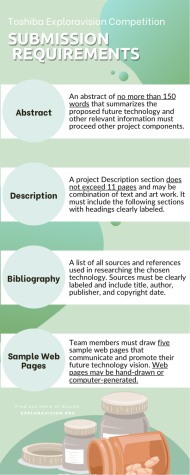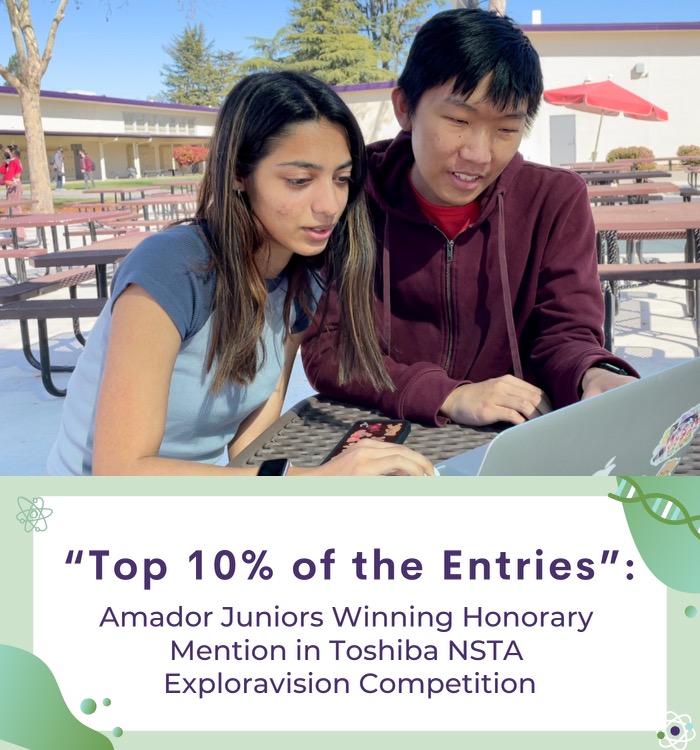“Top 10% of the entries”: Amador juniors winning honorary mention in Toshiba NSTA Exploravision competition
Wang and Modak’s win makes Amador one out of eleven high schools who entered the competition’s top 10%.
Toshiba NSTA (National Science Teachers’ Association) Exploravision competition aims to engage students from K-12 in solving real world problems through creating STEM-based projects that represent how the students envision as a solution to their chosen world problem ten years from now. Being best friends since seventh grade, the Amador students behind an honorary mention of top 10% of all submissions in the competition, Tony Wang (‘23) and Shreya Modak (‘23) were eager to take up the challenge.
“Within our research, it’s supposed to be interpretive of the future of technology in some form of STEM. So within that, they [NSTA Exploravision] required having guidelines that were like a real research paper. So the closer it was to a professional one [research paper], the better,” said Modak.
The competition requires a group of two to four students per submission and in-depth research behind any chosen topic. With a reowned history behind the Exploravision NSTA competition of more than 450,000 students submitting globally since its establishment in 1992, it was not going to be easy. And after finding out about the competition, Wang was quick to reach out to his long time friend, Modak.
“We’ve been best friends since around seventh grade. And so we really know each other well, we know each other’s working styles, so that she could keep me accountable, and I could keep her accountable. And it was just really easy to work together and kinda like put our ideas together to create a project,” said Wang.
With strict guidelines given by the Toshiba NSTA for the maximum 11-page research paper with details of an abstract, description, bibliography, and five sample Web pages, the pair eventually found a topic, or a world problem, to base their submission on.
“We became really interested in drug discovery, and how we can improve this field, since there are a lot of problems with it…In the last couple of years, ever since 1950, the cost of drug discovery has doubled every nine years. And so now it takes over a billion dollars just to bring one new drug to the market, so we really wanted to address this problem through our project,” said Wang.

Bringing their idea to life into a professional research paper wasn’t an easy process. From accumulating research related to their topic to formatting the paper to fit the guidelines, obstacles arrived one after the other as the pair continued to steadily prepare their paper for the online submission.
“One really major difficulty in our project was measuring the molecular mass of the drugs that we had made. And basically, since we were doing this on our computers, we weren’t able to do that [the experiments of the drugs] directly. So we had to write our own code to measure the molecular weights, and then convert that to molecular mass… We definitely had to do a lot of coding practice, and delve deeply into that [research],” said Wang.
Despite all hardships predating the competition, the duo’s qualities complemented each other incredibly well, given that they are partners in this virtual project and best friends in reality too.
“I would say one of the difficult parts for me was the actual annotations of the research itself… It was a lot to edit and a lot to go through and sift through… [If] you didn’t go by one of the rules, you could be disqualified… how we had to cite our sources, different kind of formatting within the research, how we presented our data – it was all very, very specific,” said Modak.
All that was left after finalizing the research paper was submission. Amongst many of the requirements behind the competition, a teacher was required to back up the submission by becoming a sponsor for the students. For Modak and Wang, that teacher was Mr. Dennis.
“When she [Shreya] and Tony came to me and asked me to be a sponsor for their project submission, I was happy to do it…My job as the sponsoring teacher was pretty easy, it was a matter of them taking their project that they had done, submitting an application, and then me adding my name to the application and saying yes, these are students at our school, yes, we are happy to support them and sponsor their application to the competition,” said Engineering teacher Mr. Dennis.
It was a notification that came through in an email during a school day that surprised the duo with the awarding of an honorary mention amongst the tens of thousands of submissions in Toshiba NSTA Exploravision competition this year.
“Honestly, I was really happy when we saw that in the email given to us. And additionally, we were one out of 11 California high schools that were within that top 10 percentage. So it feels great to be representing Amador in that sort of sense that we were able to be one of the winners for that competition here,” said Modak.
Through this experience with the Toshiba NSTA Exploravision competition, the duo were able to delve more into the STEM field as both learned a lot through their experiences.
“I’m just really excited that students like Shreya and Tony are out there seeking opportunities, finding these kinds of opportunities on their own, and coming up with ideas for their own research, I think it’s super exciting to see students thinking beyond just what they do day in and day out in their classrooms and applying that curiosity to other places where they can get acknowledgement, recognition, and maybe develop a network of contacts,” said Dennis.
For Modak and Wang, it was more than rewarding to receive recognition for all their hard work from a well-known STEM competition as they continue to pursue their passions in the STEM field in their future.
“I would definitely recommend other students to participate. Competitions like science fairs and Toshiba are definitely great opportunities to work with your friends, and also learn more about science and doing research. You can get a lot of great experiences and create great connections with people,” said Wang.
Your donation will support the student journalists in the AVJournalism program. Your contribution will allow us to purchase equipment and cover our annual website hosting costs.

